Your perfume's longevity depends on several key factors you can control. Start by applying fragrance to moisturized skin at pulse points like wrists, neck, and behind ears – but don't rub them together. Choose higher concentrations like Eau de Parfum over lighter options, and store your perfumes in cool, dark places to maintain their potency. The right application technique paired with proper skin preparation creates the perfect foundation for day-long scent. Let's explore how to maximize these elements.
Essential Factors Affecting Fragrance Duration
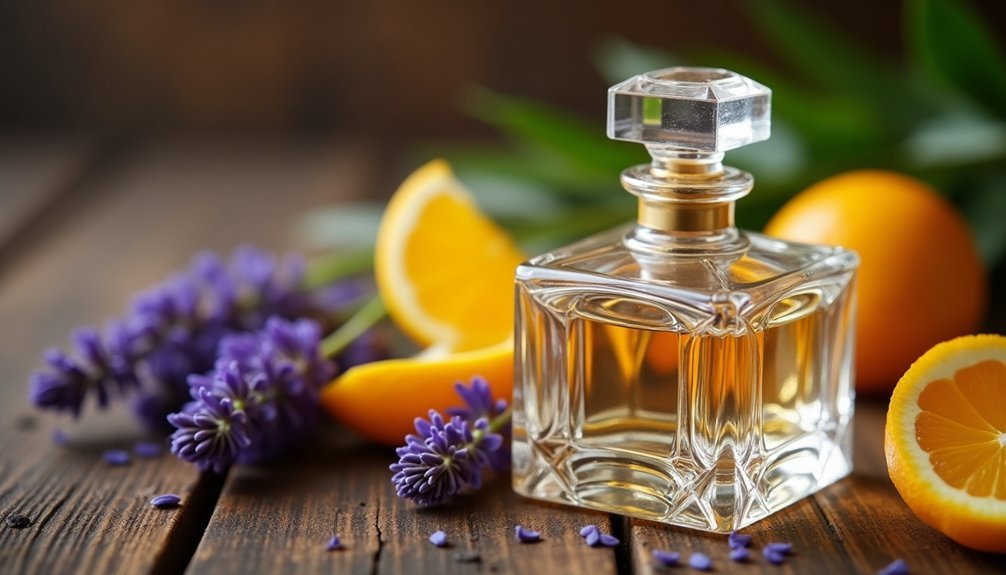
When it comes to making your perfume last throughout the day, several key factors work together to determine its staying power. The concentration of perfume oil plays an essential role, with Eau de Parfum offering nearly twice the longevity of Eau de Toilette due to its higher oil content.
Perfume longevity depends heavily on oil concentration, with Eau de Parfum lasting significantly longer than lighter formulations.
Your fragrance notes greatly impact how long the scent lingers. While citrus and floral top notes quickly fade, base notes like wood and musk create a lasting impression.
You'll get better results by applying your perfume to moisturized skin, as hydrated skin helps trap and extend the fragrance. Your application techniques matter too – target pulse points but don't rub your wrists together, as this can break down the scent molecules.
Remember that environmental conditions affect longevity, so you might need to adjust your application in dry or humid weather.
Strategic Application Points for Maximum Longevity
Although many people focus on choosing the right fragrance, knowing where to apply it can make the difference between a fleeting scent and one that lasts all day. Your pulse points are key areas where your body's natural warmth helps amplify the fragrance's projection.
To maximize your perfume's longevity, target these essential spots:
- Wrists, neck, and behind ears
- Inner elbows and backs of knees
- Ankles for rising scent effect
- Clothing for extended wear time
You'll want to prep your skin before application for the best results. Apply an unscented moisturizer first, as hydrated skin holds fragrance molecules better.
When you apply perfume to these strategic locations, don't rub your wrists together – this common mistake can actually break down the scent faster.
Proper Storage Methods to Preserve Scent Quality
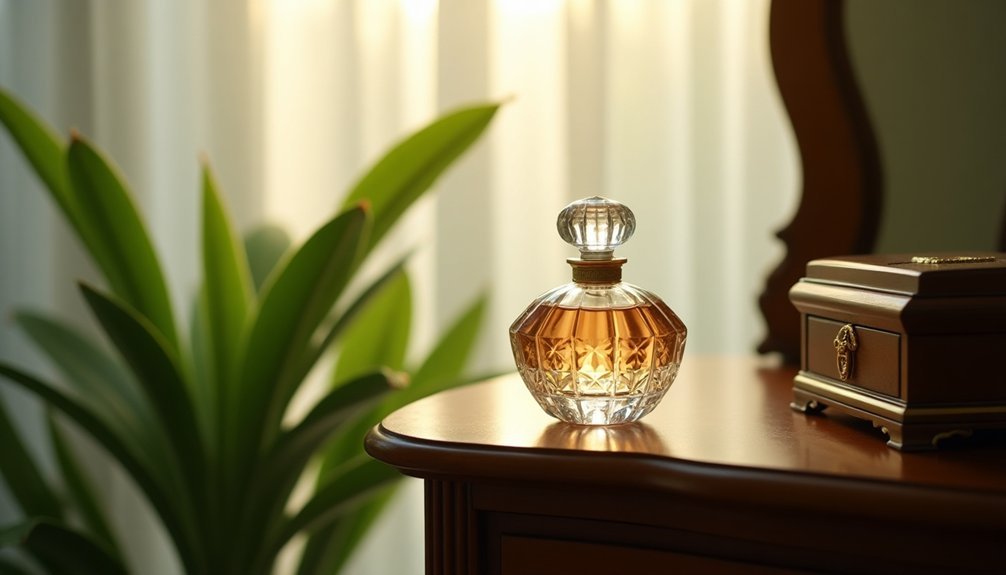
The three biggest enemies of your perfume are heat, light, and humidity. To protect your fragrance investment, proper storage methods are crucial for maintaining its quality and longevity.
You'll want to keep your perfumes in a cool, dark environment, like a beauty drawer or cabinet, where they're safe from direct sunlight and temperature fluctuations.
Avoid storing your fragrances in the bathroom, where steam and moisture can compromise their molecular structure.
Don't shake the bottles, as this introduces unwanted air that can alter the scent's composition.
For ideal preservation, consider keeping your perfumes in the refrigerator, where consistent cool temperatures help maintain their potency.
Choosing the Right Fragrance Concentration
Your perfume's staying power largely depends on its concentration, with higher oil-to-alcohol ratios delivering longer-lasting scents.
If you're seeking all-day wear, you'll want to opt for extrait de parfum or eau de parfum (EDP), which contain 20-40% and 15-20% perfume oils respectively.
While eau de toilette (EDT) offers a lighter option with 5-15% concentration, it won't provide the same extended wear time as its stronger counterparts.
Perfume Strength Matters Most
When selecting a fragrance that lasts all day, concentration levels make the biggest difference in performance. The higher the perfume strength, the longer it'll stay with you throughout your day.
Fragrance oil concentration directly impacts longevity, which is why extrait de parfum and eau de parfum outperform lighter formulations.
Here's what you'll get with different concentrations:
- Extrait de Parfum: Highest concentration, lasting 8+ hours with complex scent profiles
- Eau de Parfum (EDP): 15-20% fragrance oils, lasting 4-8 hours
- Eau de Toilette (EDT): 5-15% fragrance oils, lasting 2-4 hours
- Cologne: Lowest concentration, lasting 2-3 hours
For all-day wear, opt for fragrances with higher concentrations of essential oils, particularly those featuring lasting base notes like woods and musks.
Oils Versus Alcohol Content
Understanding the balance between oils and alcohol in your fragrance can make or break its staying power. When you're selecting a perfume, consider that higher oil concentrations will give you considerably longer longevity.
While alcohol helps disperse the scent, too much can cause it to evaporate quickly from your skin.
You'll find the most lasting power in Extrait de Parfum, with up to 40% oils, followed by Eau de Parfum at 15-20%. If you're looking for all-day wear, these concentrations will serve you better than lighter options like Eau de Toilette, which contains just 5-15% oils.
The higher oil content doesn't just affect longevity—it also creates a more complex scent that evolves throughout the day. Remember that rich base notes in oil-heavy fragrances will linger longer than volatile top notes.
Skin Preparation Techniques Before Application
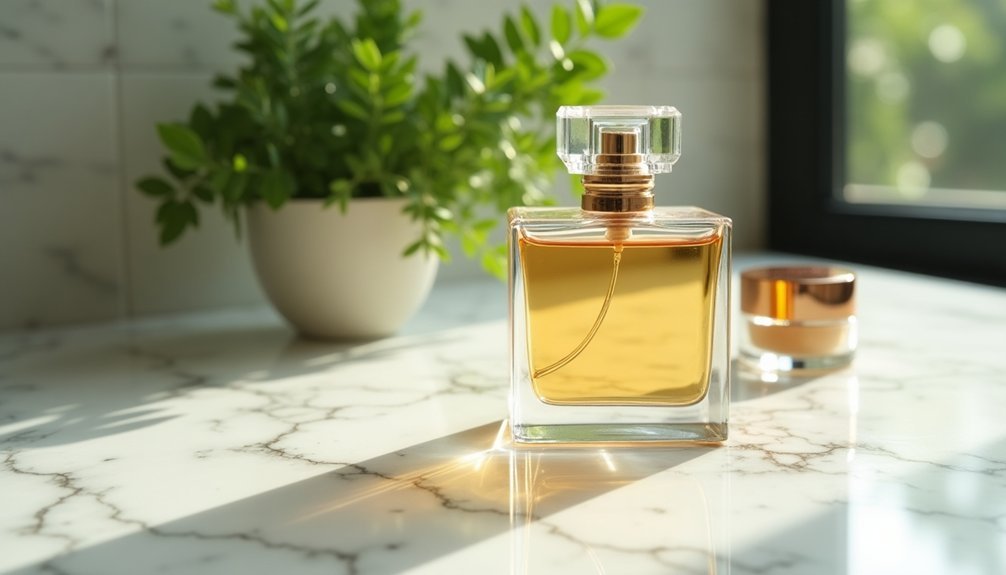
Preparing your skin correctly before applying perfume is the secret to making your fragrance last all day. Your skin needs to be well-moisturized to create the perfect foundation for a long-lasting scent. You'll get the best results by applying your perfume right after showering when your skin is still slightly damp.
To maximize your fragrance's staying power:
- Start with a warm shower to open your pores
- Pat skin semi-dry, leaving it slightly damp
- Apply an unscented moisturizer to create a neutral base
- Wait 30 seconds before applying your perfume
For even better results, consider layering your fragrances using matching scented products.
Focus on applying perfume to well-hydrated pulse points, where your body's natural warmth will help diffuse the scent throughout the day.
Environmental Impact on Perfume Performance
The success of your perfume depends heavily on the environment around you, as factors like temperature, humidity, and sunlight play essential roles in how long your fragrance will last.
When you're in a hot climate, you'll notice your perfume fading faster because heat accelerates the evaporation of scent molecules. Similarly, high humidity can make your fragrance dissipate more quickly into the air.
If you're dealing with low humidity, your skin might become dry, making it harder for the scent to cling to your body effectively.
Direct sunlight is another concern, as it can break down the fragrance molecules and alter your perfume's intended scent.
To maximize your perfume's longevity, try to store it in a cool, consistent-temperature environment away from light exposure.
Layering Methods for Extended Wear Time
When it comes to making your perfume last longer, mastering the art of fragrance layering can transform your scent experience.
You'll get the most longevity by starting with well-moisturized skin, applying an unscented lotion before your perfume. This creates the perfect canvas for your signature scent to cling to throughout the day.
For maximum staying power, try these proven layering techniques:
- Start with a matching shower gel to build your scent foundation.
- Apply a light body mist as your base layer.
- Follow with your main eau de parfum.
- Finish with strategic spritzes on clothing, especially natural fabrics.
Don't be afraid of layering different fragrances to create your unique scent profile.
Testing Your Perfume's Staying Power
You'll want to track your perfume's scent evolution by checking its intensity every hour after application, paying special attention to how the fragrance notes develop and change.
Keep a simple log of when certain scent aspects begin to fade, which will help you understand your perfume's lasting power on your skin.
Track Scent Evolution Hourly
Understanding your perfume's true staying power requires a methodical approach to tracking its scent evolution throughout the day. By documenting specific intervals, you'll gain insights into how your fragrance develops and maintains its longevity on your skin.
To effectively monitor your perfume's progression, follow these key time markers:
- First 30 minutes: Observe the vibrant top notes
- 1-2 hours: Notice the emergence of heart notes
- 3-4 hours: Experience the deep base notes
- 6+ hours: Assess the final dry-down phase
Keep a fragrance journal to record how environmental factors affect your scent's performance. Note whether humidity intensifies the fragrance or if temperature changes alter its projection.
Don't forget to compare how the perfume behaves on your skin versus clothing, as this can greatly impact its staying power.
Document Fragrance Fade Patterns
After tracking your perfume's hourly evolution, testing its actual staying power provides concrete data about its performance.
To understand fragrance fade patterns, apply your perfume at different times throughout the day and document exactly when the scent begins to diminish. You'll want to monitor temperature and humidity levels during each test, as these environmental factors greatly impact longevity.
Test your body chemistry by measuring your skin's pH levels, which directly affects how the fragrance interacts with your skin.
Compare eau de parfum versus eau de toilette under identical conditions to determine which concentration lasts longer. Pay special attention to how different notes evaporate – top notes typically fade first, while middle and base notes linger.
This systematic approach helps you identify the ideal conditions for maximum fragrance performance.
Frequently Asked Questions
How to Make Perfume Last All Day?
Apply your perfume on damp, moisturized skin after showering, targeting pulse points. Don't rub your wrists together. Choose eau de parfum formulas and layer with matching scented products for all-day fragrance staying power.
Why Can't I Smell My Perfume All Day?
You can't smell your perfume all day because your nose becomes desensitized to familiar scents. Also, your body chemistry, dry skin, and environmental factors affect how quickly fragrance notes evaporate and dissipate.
Which Thing Makes Perfume Long Lasting?
You'll get longer-lasting perfume by choosing higher concentration EDPs, applying it to moisturized skin and pulse points, selecting fragrances with strong base notes, and storing your perfume properly in cool, dark places.
What Makes Some Perfumes Last Longer?
Your perfume lasts longer when it has higher fragrance oil concentrations, like extrait de parfum, and contains base notes like woods and musks. Applying it to moisturized skin at pulse points also improves longevity.
In Summary
You'll get the most out of your perfume by combining several key strategies. Focus on proper skin preparation, strategic application on pulse points, and smart storage techniques. Choose higher fragrance concentrations, layer complementary scents, and consider environmental factors affecting longevity. With these methods, you're set to enjoy your signature scent from morning to night. Test different approaches to find what works best for you.
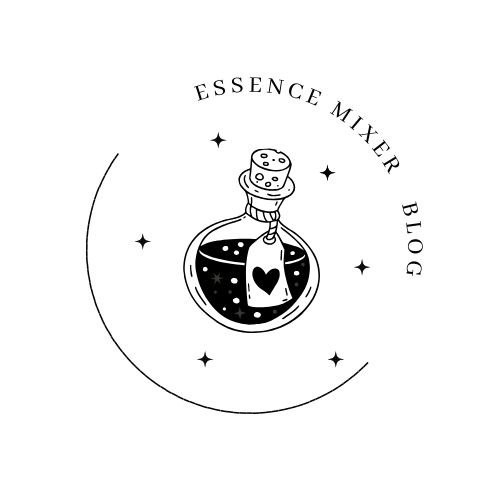
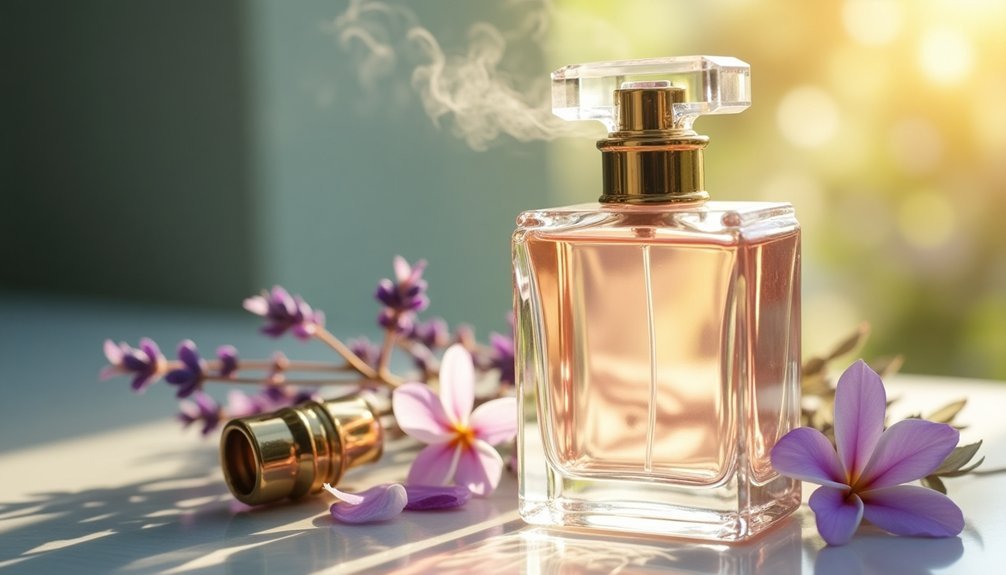



Leave a Reply